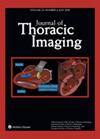Evaluation of the Pulmonary Arteries on CTPA With Dual Energy CT: Objective Analysis and Subjective Preferences in a Multireader Study.
IF 2
4区 医学
Q3 RADIOLOGY, NUCLEAR MEDICINE & MEDICAL IMAGING
引用次数: 0
Abstract
PURPOSE To perform qualitative and quantitative evaluation of low-monoenergetic images (50 KeV) compared with conventional images (120 kVp) in pulmonary embolism (PE) studies and to determine the extent and clinical relevance of these differences as well as radiologists' preferences. MATERIALS AND METHODS One hundred fifty CT examinations for PE detection conducted on a single-source dual-energy CT were retrospectively evaluated. Attenuation, contrast-to-noise-ratio, and signal-to-noise-ratio were obtained in a total of 8 individual pulmonary arteries on each exam-including both central (450/1200=37.5%) and peripheral (750/1200=62.5%) locations. Results were compared between the conventional and low-monoenergetic images. For quality assessment, 41 images containing PE were presented side-by-side as pairs of slices in both conventional and monoenergetic modes and evaluated for ease in embolus detection by 9 radiologists: cardiothoracic specialists (3), noncardiothoracic specialists (3), and residents (3). Paired samples t tests, a-parametric Wilcoxon test, McNemar test, and kappa statistics were performed. RESULTS Monoenergetic images had an overall statistically significant increased average ratio of 2.09 to 2.26 (P<0.05) for each measured vessel attenuation, with an increase in signal-to-noise ratio (23.82±9.29 vs. 11.39±3.2) and contrast-to-noise ratio (17.17±6.7 vs 7.27±2.52) (P<0.05). Moreover, 10/150 (6%) of central pulmonary artery measurements considered suboptimal on conventional mode were considered diagnostic on the monoenergetic images (181±14.6 vs. 387.7±72.4 HU respectively, P<0.05). In the subjective evaluation, noncardiothoracic radiologists showed a preference towards low-monoenergetic images, whereas cardiothoracic radiologists did not (74.4% vs. 57.7%, respectively, P<0.05). CONCLUSIONS The SNR and CNR increase on monoenergetic images may have clinical significance particularly in the setting of sub-optimal PE studies. Noncardiothoracic radiologists and residents prefer low monoenergetic images.用双能 CT 评估 CTPA 上的肺动脉:多机研究中的客观分析和主观偏好。
材料和方法回顾性评估了在单源双能量 CT 上进行的 150 次肺栓塞检测 CT 检查。在每次检查中,共获得了 8 条单独肺动脉的衰减、对比度-噪声比和信号-噪声比,包括中心位置(450/1200=37.5%)和外周位置(750/1200=62.5%)。对传统图像和低单能量图像的结果进行了比较。为了进行质量评估,9 位放射科专家(心胸科专家 3 位、非心胸科专家 3 位和住院医师 3 位)将 41 张含有 PE 的图像以常规和单能量模式并排切片显示,并对栓子检测的难易程度进行评估。进行了配对样本 t 检验、参数 Wilcoxon 检验、McNemar 检验和 kappa 统计。每个测量血管衰减的平均比值从 2.09 增加到 2.26(P<0.05),信噪比(23.82±9.29 vs. 11.39±3.2)和对比度-噪声比(17.17±6.7 vs. 7.27±2.52)均有所增加(P<0.05)。此外,10/150(6%)的中心肺动脉测量结果在常规模式下被认为是不理想的,但在单能图像上被认为是有诊断意义的(分别为 181±14.6 HU vs. 387.7±72.4 HU,P<0.05)。在主观评价中,非心胸外科放射医师倾向于低单能图像,而心胸外科放射医师则不然(分别为 74.4% 对 57.7%,P<0.05)。非心胸放射科医生和住院医生更喜欢低单能图像。
本文章由计算机程序翻译,如有差异,请以英文原文为准。
求助全文
约1分钟内获得全文
求助全文
来源期刊

Journal of Thoracic Imaging
医学-核医学
CiteScore
7.10
自引率
9.10%
发文量
87
审稿时长
6-12 weeks
期刊介绍:
Journal of Thoracic Imaging (JTI) provides authoritative information on all aspects of the use of imaging techniques in the diagnosis of cardiac and pulmonary diseases. Original articles and analytical reviews published in this timely journal provide the very latest thinking of leading experts concerning the use of chest radiography, computed tomography, magnetic resonance imaging, positron emission tomography, ultrasound, and all other promising imaging techniques in cardiopulmonary radiology.
Official Journal of the Society of Thoracic Radiology:
Japanese Society of Thoracic Radiology
Korean Society of Thoracic Radiology
European Society of Thoracic Imaging.
文献相关原料
| 公司名称 | 产品信息 | 采购帮参考价格 |
|---|
 求助内容:
求助内容: 应助结果提醒方式:
应助结果提醒方式:


